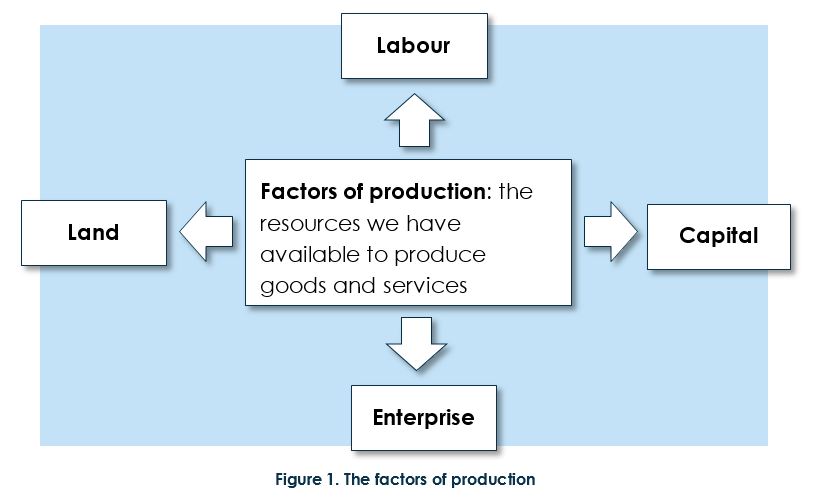IB Diploma Economics:
|
|
IB Economics – learning outcomes:
|
SCARCITY – FACTORS OF PRODUCTION ARE FINITE AND WANTS INFINITE
|
Needs, wants and resources.
Our needs and wants are very different. We need some things just to stay alive – including water, food and warmth. But our wants are never-ending (infinite). We may want a PlayStation 4 for Christmas. Do we actually need it to stay alive? Most people would say no – it is simply a luxury that would be nice to have. Imagine you get a PlayStation for Christmas – what will you want for your birthday? An iPhone, perhaps. The cycle of wants continues, once you get one thing, you move straight on to wanting another. In contrast, the resources used to produce these goods and services are in limited supply (finite). Collectively, resources are called factors of production. Resources can be divided into four groups:
Production of goods and services. Goods are items that you can touch (tangible) – you can take them home and use them. An example of a good is a pen or a packet of crisps. A service is something that someone provides for you; you cannot touch it (intangible). Examples include tourism and banking. The production of nearly all goods and services uses up scarce resources. Production takes place in one of three sectors, as shown in the table. |
|
as a result of scarcity, choices have to be made
The basic economic problem.
The basic economic problem occurs because resources are scarce – but our wants are infinite. As resources are scarce and our wants are never-ending, we have to allocate resources. When we allocate resources, we ask the following questions:
When allocating resources, individuals, firms and governments must all make decisions about what, how, and for whom.
The basic economic problem occurs because resources are scarce – but our wants are infinite. As resources are scarce and our wants are never-ending, we have to allocate resources. When we allocate resources, we ask the following questions:
- What goods and services should we produce?
- How should the economy use its resources to operate schools or hospitals?
- What mix of goods will it produce?
- What is the best way to produce goods and services?
- What is the best use of scarce resources?
- Who is to receive goods and services?
When allocating resources, individuals, firms and governments must all make decisions about what, how, and for whom.
every economic choice has an associated opportunity cost
|
Opportunity costs and choices.
We already know that resources are scarce and we have infinite wants. This creates a problem; if we cannot have everything we want, we have to make choices. I really want to go on holiday and I would like a new car. I do not have the money to do both, so I must decide which I would like to do the most. If I choose to go on holiday, it means I cannot buy a new car. I can therefore say that the opportunity cost of going on holiday is buying a car. This means that when I have chosen the holiday, the next best alternative is the car. Thus, because we cannot have everything we want as a result of scarcity, every choice that must be made between two or more options has an opportunity cost. |
Opportunity cost – the next best alternative foregone when making a choice – what we give up when we make a choice.
|
ECONOMIC QUESTIONS THAT MUST BE ANSWERED BY ANY ECONOMIC SYSTEM
|
Scarcity makes every economy in the world, regardless of how it is organised, to answer three basic questions – What to produce? How to produce? For whom to produce? The first two questions are about resource allocation.
Resource allocation refers to assigning an economy’s available resources, i.e., the factors of production, to certain uses which have to be chosen among the many possible alternatives available. For example, if ‘a what to produce?’ choice involves choosing a certain amount of education services (schools, universities, etc.) and a certain amount of health care (medical centres, hospitals, etc.), this means a decision is made to allocate some resources to the production of education and some to the production of health services. At the same time, a choice needs to be made about how to produce these services. Which factors of production (e.g., labour – doctors, nurses, dentists, teachers, professors, and capital – buildings, information systems, equipment) and in what quantities (for example, how much labour, how much capital equipment and what type of capital equipment, etc.) should be used to deliver health care and how much to deliver education services. Bearing in mind that resources are scare relative to needs and wants, if a decision is made to change the amounts of services produced, such as more education and less health care, this involves a reallocation of resources. Sometimes, economies do not produce the best amount of goods and services relative to what is socially desirable. For example, if too many cigarettes or alcohol are being produced, then there is an overallocation of resources in production of cigarettes or alcohol. If too few socially desirable goods or services are being produced, such as health care or education, then there is an underallocation of resources in producing these services. |
The third and final question, ‘for whom to produce’ is about the distribution of output, i.e., how much output different individuals or different groups in the economy receive.
Here the distribution of income among individuals and groups in an economy becomes an important consideration. To a large he amount of output different people receive depends on how much of it they can buy, which is dependent on how much income they receive. When the distribution of income or output changes so that different social groups now receive more, or less, income and output than previously (e.g., taxing the rich to provide education for the poor), this is referred to as redistribution of income. Wealth and income DistributionDifferent economic systems |
economics examines how resources are allocated
|
The economic problem – sometimes called the basic, central, or fundamental economic problem – is one of the fundamental economic theoretical principles in the operation of any economy. It states that there is scarcity; that is, that the finite resources available are insufficient to satisfy all human wants and needs. The question then becomes how to determine what is to be produced, and how the factors of production (such as capital and labour) are to be allocated. Economics revolves around methods and possibilities of solving this fundamental economic problem.
The economic problem can be divided into different parts: 1. Problem of allocation of resources The problem of allocation of resources arises due to the scarcity of resources, and refers to the question of which wants should be satisfied and which should be left unsatisfied; in other words, what to produce and how much to produce. More production of a good implies more resources required for the production of that good, and resources are scarce. These two facts together mean that, if a society decides to increase production of some good, it has to withdraw some resources from the production of other goods; in other words, more production of a desired commodity can be made possible only by reducing the quantity of resources used in the production of other goods. The problem of allocation deals with the question of whether to produce capital goods or consumer goods. If the community decides to produce capital goods, resources will have to be withdrawn from the production of consumer goods. However, in the long run, the investment on capital goods will increase the ability to produce consumer goods. Thus, both capital and consumer goods are important. The problem is determining what the optimal ratio of production between the two types of goods is.it is a social science that studies human behaviour as a relationship between end and scarce means that have alternative uses. 2. The problem of economic efficiency Resources are scarce and it is important to use them as efficiently as possible. Thus, it is essential to know if the production and distribution of national product made by an economy is maximally efficient. The production becomes efficient only if the productive resources are used in such a way that any reallocation does not produce more of one good without reducing the output of any other good; in other words, ‘efficient distribution’ means that any redistribution of goods cannot make anyone better off without making someone else worse off. The inefficiencies of production and distribution exist in all types of economies. The welfare of the people can be increased if these inefficiencies are ruled out. |
3. The problem of full-employment of resources
In view of the scarce resources, the question of whether all available resources are being fully employed is an important one. An economy should achieve maximum satisfaction by using the scarce resources in the best possible manner; resources should not be wasted or used inefficiently. However, in capitalist economies, the available resources are not fully employed. In times of recession, there are many people willing and wanting to work who go without employment. It supposes that the scarce resources are not fully being used in a capitalist economy. 4. The problem of economic growth If the productive capacity of the economy grows, it will be able to produce progressively more goods, which will result in a rise in the standard of living of the people in that economy. The increase in productive capacity of an economy is called economic growth. There are various factors affecting economic growth including the allocation of resources to capital goods, investment in technology and skills and education training to raise the productivity of labour. This part of economic problem is studied in the economies of development. Economic growth |
Key Terms:
|
|
PROGRESS CHECK – Assess YOUR UNDERSTANDING by Completing The Activities below
You have below, a range of practice activities, flash cards, exam practice questions and an online interactive self test to ensure you have complete mastery of the IB Economics requirements for the introductory Foundations of Economics topic.
Foundations of IB Economics Flashcards
IB Economics interactive QUIZZES AND TWO CLASSROOM GAMES
|
Test how well you know the IB Economics Microeconomics – Foundations of Economics topic with the self-assessment tool. Aim for a score of at least 80 per cent.
|




























